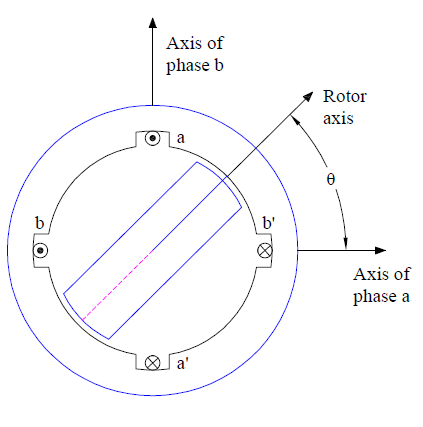Switched Reluctance Motor (SRM) is also known as Variable Reluctance Motor. This motor works on the principle of variable reluctance. This means, the rotor always tries to align along the lowest reluctance path. As the name suggests, a switching inverter is required for the operation of Switched Reluctance Motor.
Construction of Switched Reluctance Motor
Variable Reluctance Motor or Switched Reluctance Motor has two different constructions: Singly Salient Construction and Doubly Salient Construction. Stator and rotor magnetic circuits are laminated to reduce the core losses in both type of SRM.
Singly Salient Construction:
A singly salient construction SRM comprises of a non-salient stator and a salient two pole rotor. The rotor do not have any winding wound over it but the stator have two phase winding as shown in figure below.

It should be noted that, in actual SRM the number of phase winding on stator may be more than two. Since the rotor is of salient construction, the inductance of stator phase winding varies with the rotor position. The inductance is minimum when the rotor axis and stator phase winding axis coincides whereas it is maximum when both the axis are in quadrature.
Doubly Salient Construction:
Unlike singly salient type, the stator of doubly salient Switched Reluctance Motor is of salient construction and consists of four poles as shown in figure below. The rotor do not carry any winding and is of salient construction but have two poles. Thus this type of SRM is a hetropolar motor where the numbers of stator and rotor poles are not same.

The stator phase windings are concentrated winding. These concentrated windings on radially opposite poles are either connected in series or parallel to result into two phase winding on stator.
A doubly salient type Switched Reluctance Motor or variable Reluctance Motor produces more torque as compared to singly salient type for the same size. Therefore a doubly SRM is more common and widely used.
Working principle of Switched Reluctance Motor (SRM)
As we know that magnetic flux have a tendency to flow through lowest reluctance path, therefore rotor always tends to align along the minimum reluctance path. This is the basic working principle of Switched Reluctance Motor or Variable Reluctance Motor.
Therefore, when stator phase winding A is energized, the rotor align along this phase as shown in figure below.

When stator phase winding A is de-energized and winding B is energized, the rotor align itself along B phase as shown in figure below.

Similarly, the rotor occupies a position along phase winding C when this phase is energized.

Thus rotor rotation in clockwise direction is achieved by energizing the phase winding in a ABC sequence. If rotor rotation in anti-clockwise direction is require, stator phase winding must be energized in ACB sequence.
It must also be noted that, a particular phase winding must be energized / de-energized in synchronism with rotor position. This means as soon as the rotor align along the A phase, B phase must be energized and A phase must be de-energized if clockwise rotor rotation is required.
To better understand the working principle, carefully observe the animation of Switched Reluctance Motor given below.

Your articles are always helpful and easy to understand.
Thank You..
Thank you!
this operation is same as the stepper motor …there is no any difference?
after de energising phase A, and energising phase B, in the above animation case rotor is taking anti clockwise but u claimed that it has to be in clockwise how?